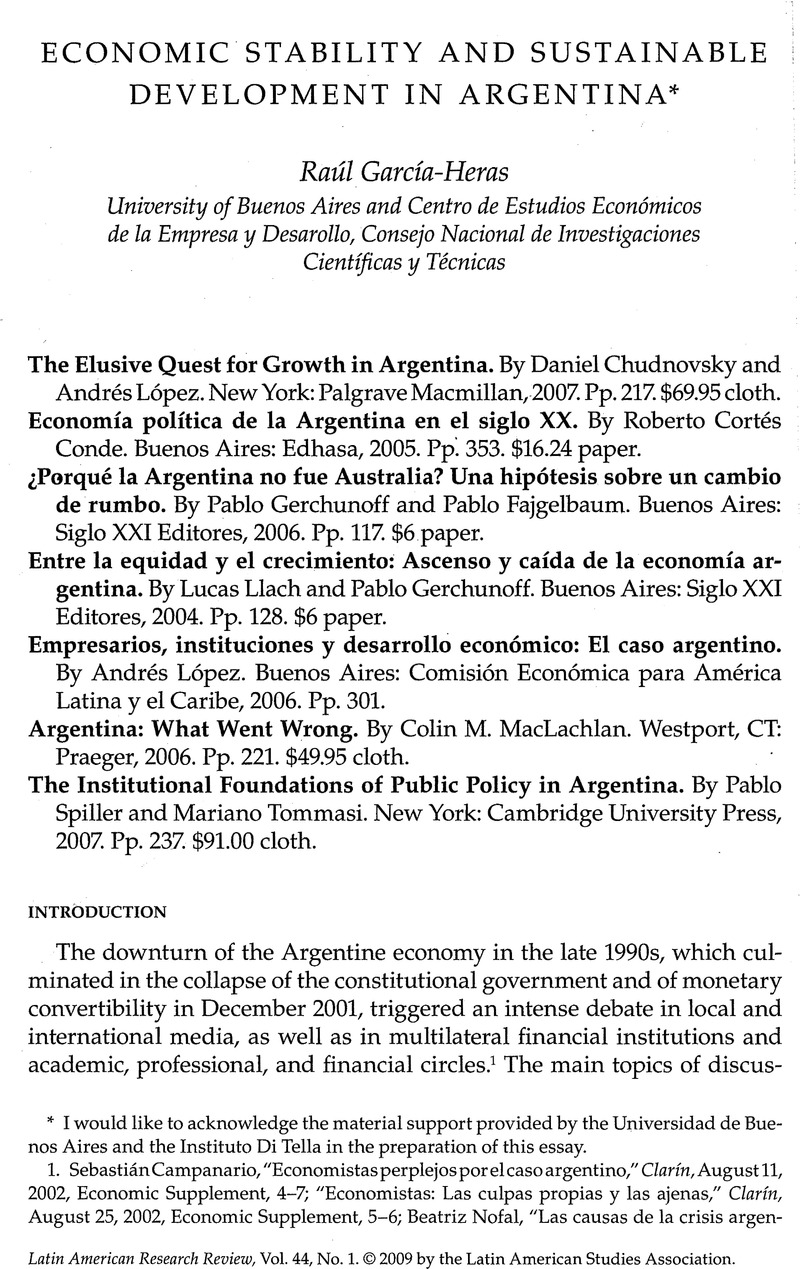Article contents
Economic Stability and Sustainable Development in Argentina
Review products
Published online by Cambridge University Press: 05 September 2022
Abstract

- Type
- Review Essays
- Information
- Copyright
- Copyright © 2009 by the Latin American Studies Association
Footnotes
I would like to acknowledge the material support provided by the Universidad de Buenos Aires and the Instituto Di Tella in the preparation of this essay.
References
1. Sebastián Campanario, “Economistas perplejos por el caso argentino,” Clarín, August 11, 2002, Economic Supplement, 4–7; “Economistas: Las culpas propias y las ajenas,” Clarín, August 25, 2002, Economic Supplement, 5–6; Beatriz Nofal, “Las causas de la crisis argentina,” Boletín Informativo Techint 310 (May-August 2002): 81–119. These assessments were published as the Argentine economy was beginning to recover from the crisis.
2. The depth of the crisis was measured by economic indicators in comparison with the crises of Thailand (1997), Russia (1998), and Brazil (1999). See Luciana Díaz Frers, “La Argentina con un triste récord mundial,” La Nación, June 23, 2002, Economía y Negocios, 2; and El Cronista Comercial, March 9, 2005, 25.
3. Carlos Díaz Alejandro, Ensayos sobre la historia económica argentina (Buenos Aires: Amorrortu, 1970); Gerardo Dellapaolera and Alan Taylor, Straining at the Anchor: The Argentine Currency Board and the Search for Macroeconomic Stability, 1880–1935 (Chicago: University of Chicago Press, 2001); and A New Economic History of Argentina (Cambridge: Cambridge University Press, 2003).
4. For a summary of these debates, see Juan José Llach, La Argentina que no fué: Las fragilidades de la Argentina agroexportadora, 1918–1930 (Buenos Aires: Editorial del IDES, 1985), 28–35; and Reconstrucción y estancamiento (Buenos Aires: Editorial Tesis, 1987), 36–41.
5. Oscar Braun and Leonard Joy, “A Model of Economic Stagnation: A Case Study of the Argentine Economy,” The Economic Journal 78, no. 312 (1968): 868–887; Díaz Alejandro 1970, 351–390; Marcelo Diamand, “La estructura productiva desequilibrada argentina y el tipo de cambio,” Desarrollo Económico 12, no. 45 (1972): 25–47, and El péndulo argentino: ¿Hasta cuando? (Buenos Aires: CERES, 1984). Diamand argues that Argentina's economic instability is due to an “unbalanced productive structure.”
6. “Hay que terminar con el péndulo argentino,” El Cronista Comercial, October 10, 2003, 10.
7. Javier González Fraga, “¿Adiós a la montaña rusa?” Perfil, April 23, 2006, 23.
8. Roberto Cortés Conde, Progreso y declinación de la economía argentina (Buenos Aires: Fondo de Cultura Económica, 1998).
9. Angus Maddison, The World Economy: Historical Statistics (Paris: Organisation for Economic Co-operation and Development Development Centre, 2003).
10. Pablo Gerchunoff and Lucas Llach, El ciclo de la ilusión y el desencanto (Buenos Aires: Ariel, 1998).
11. Juan Cerruti, “Porqué la geografía no es siempre destino,” El Cronista Comercial, December 11, 2003, 4.
12. Ibid., 4.
13. Díaz Alejandro 1970, 67–140; John Fogarty, Ezequiel Gallo, and Héctor Diéguez, Argentina y Australia (Buenos Aires: Instituto Torcuato Di Tella, 1979); Tim Duncan and John Fogarty, Australia and Argentina: On Parallel Paths (Melbourne, Australia: Melbourne University Press, 1984), especially 160–172; D. C. M. Platt and Guido Di Tella, Argentina, Australia and Canada: Studies in Comparative International Development, 1870–1965 (New York: St. Martin's Press, 1985).
14. Ricardo Caballero and Rudiger Dornbusch, “Argentina: A Rescue Plan That Works,” February 27, 2002, http://web.mit.edu/rudi/www; and Clarín, April 28, 2002, Economic Supplement, 2.
15. Luis Secco, “Instituciones para el crecimiento,” La Nación, November 14, 2004, Economía y Negocios, 9; Aldo Abram, “Por instituciones más precisas,” La Nación, December 30, 2007, Economía y Negocios, 6; and Diego Gauna, “El crecimiento y las instituciones,” Clarín, April 20, 2008, Economic Supplement, 6.
16. Llach, Reconstrucción y estancamiento, 15.
17. Kathryn Sikkink, “Las capacidades y la autonomía del estado en Brasil y la Argentina: Un enfoque neoinstitucionalista,” Desarrollo Económico 32, no. 128 (1993): 543–574.
18. Marcelo Bonelli, “Para recrear la burguesía nacional faltan medidas,” Clarín, October 17, 2003, 6.
19. See, e.g., Alfredo Zaiat, “La burguesía nacional,” Página 12, April 3, 2005, Economic Supplement: “Cash,” 12; and the interview with Argentine economist Eric Calcagno Jr., in Hoy, February 1, 2004, 7.
20. Guillermo O'Donnell, “State and Alliances in Argentina, 1956–1976,” Journal of Development Studies 15, no. 1 (1978): 3–33.
21. See the chapter by Berenztein and Spector in Dellapaolera and Taylor, A New Economic History of Argentina (New York: Cambridge University Press, 2003), 324–368, 372, 374.
22. Marcelo Rougier, Industria, finanzas e instituciones en la Argentina: La experiencia del Banco Nacional de Desarrollo (Bernal, Argentina: Universidad Nacional de Quilmes, 2004).
23. Stephan Haggard and Robert Kaufman, The Politics of Economic Adjustment (Princeton, NJ: Princeton University Press, 1992).
- 1
- Cited by


